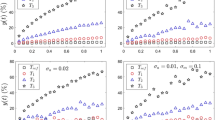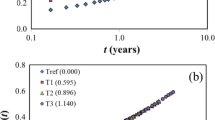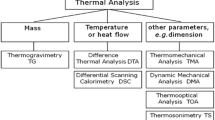Abstract
In a recent publication, we carried out an extensive analysis of an unsupervised method of determining optimum shift factors in time-temperature-superposition of accelerated-aging data that involves minimizing the vertical arclength to obtain the master curve. For synthetic Arrhenius data with a variety of noise distributions, the work showed that, in conjunction with bootstrap-resampling, the method can produce reliable estimates of the mean activation energy along with uncertainty quantification. The present work applies the above method to six different datasets taken from the published literature and demonstrates accurate prediction of mean activation energy from the data as-is without the need for any pre-processing or fitting. It also compares uncertainty margins computed by second-order bootstrap with that by linear regression theory and shows that the former appears to provide consistent margins in the presence of common noise types in real data, including intra-isotherm measurement-errors, sample-to-sample variations, and intrinsic deviation from perfect Arrhenius behavior.



Similar content being viewed by others
References
Bae J-E, Cho KS, Seo KH, Kang D-G (2011) Application of geometric algorithm of time-temperature superposition to linear viscoelasticity of rubber compounds. Korea-Aust Rheol J 23:81–87
Barbero EJ, Ford KJ (2004) Equivalent time temperature model for physical aging and temperature effects on polymer creep and relaxation. ASME J Eng Mater Technol 126:413–419
Bari J (2005) Development of a new revised version of the Witczak E* predictive models for hot mix asphalt systems. PhD Dissertation Thesis, Civil Engineering, Arizona State University
Bari J, Witczak MW (2005) Evaluation of the effect of lime modification on the dynamic modulus stiffness of hot-mix asphalt: use with the new mechanistic empirical pavement design guide. Transp Res Rec 1929:10–19
Bozdogan H (1987) Model selection and Akaike’s information criterion (AIC): the general theory and its analytical extensions. Psychometrika 52:345–370
Buttlar WG, Roque R, Reid B (1998) Automated procedure for generation of creep compliance master curve for asphalt mixtures. J Transp Res Board 1630:28–36
Celina M, Graham AC, Gillen KT, Assink RA, Minier LM (2000) Thermal degradation studies of a polyurethane propellant binder. Rubber Chem Technol 73:678–693
Cho KS (2009) Geometric interpretation of time-temperature superposition. Korea-Aust Rheol J 21:13
Cho KS (2016) Viscoelasticity of Polymers, Ch. 8. Springer, Dordrecht
Christensen RM (1971) Theory of viscoelasticity – an introduction. Academic Press, New York
Ding H-Z, Wang ZD (2007) Time–temperature superposition method for predicting the permanence of paper by extrapolating accelerated ageing data to ambient conditions. Cellulose 14:171–181
Efron B, Tibshirani R (1986) Bootstrap methods for standard errors, confidence intervals, and other measures of statistical accuracy. Stat Sci 1:54–75
Ekenstam A (1936) The behaviour of cellulose in mineral acid solutions: kinetic study of the decomposition of cellulose in acid solutions. BER 69:553
Emsley AM, Stevens GC (1994) Kinetics and mechanisms of the low temperature degradation of cellulose. Cellulose 1:26–56
Ferry JD (1980) Viscoelastic properties of polymers. Wiley, New York
Gergesova M, Zupancic B, Supranov I, Emri I (2011) The closed form t-T-P shifting (CFS) algorithm. J Rheol 55:1–16
Gillen KT, Clough RL (1989) Time-temperature-dose rate superposition: a methodology for extrapolating accelerated radiation aging data to low dose rate conditions. Polym Degrad Stab 24:137–168
Gillen KT, Bernstein R, Celina M (2015) Challenges of accelerated aging techniques for elastomer lifetime predictions. Rubber Chem Technol 88:1–27
Hermida EB, Povolo F (1994) Analytical-numerical procedure to determine if a set of experimental curves can be superimposed to form a master curve. Polym J (Tokyo, Jpn) 26:981
Honerkamp J, Weese J (1993) A note on estimating mastercurves. Rheol Acta 32:57–64
ISO 18437-6 (2017) Mechanical vibration and shock -- characterization of the dynamic mechanical properties of visco-elastic materials -- Part 6: Time-temperature superposition, BSI Standards Ltd
Johnson RH, Wichern DW (2007) Applied Multivariate Statistical Analysis, 6th edn. Prentice Hall, New Jersey
Knauss WG (2008) The sensitivity of the time-temperature shift process to thermal variations — a note. Mech Time-Depend Mater 12:179–188
Krauklis AE, Akulichev AG, Gagani AI, Echtermeyer AT (2019) Time–temperature–plasticization superposition principle: predicting creep of a plasticized epoxy. Polymers 11:1848
Laidler KJ (1987) Chemical kinetics, harper and row, New York
Maiti A (2016) A geometry-based approach to determining time-temperature superposition shifts. Rheol Acta 55:83–90
Maiti A (2019) Second-order statistical bootstrap for the uncertainty quantification of time-temperature-superposition analysis. Rheol Acta 58:261–271
Maiti A, Small W, Lewicki JP, Chinn SC, Wilson TS, Saab AP (2019) Age-aware constitutive materials model for a 3D printed polymeric foam. Sci Rep (Nature) 9:15923
Mochizuki K, Takayama K (2014) Prediction of color changes using the time–temperature superposition principle in liquid formulations. Chem Pharm Bull 62:1225–1230
Naya S, Meneses A, Tarrio-Saavedra J, Artiaga R, Lopez-Beceiro J, Gracia-Fernandez C (2013) New method for estimating shift factors in time–temperature superposition models. J Therm Anal Calorim 113:453–460
Shibata R (1989) Statistical aspects of model selection. In: Williems JC (ed) From Data to Model. Springer-Verlag, New York, pp 215–240
Williams ML (1964) Structural analysis of viscoelastic materials, AIAA, J. 2, 785
Williams ML, Landel RF, Ferry JD (1955) The temperature dependence of relaxation mechanisms in amorphous polymers and other glass-forming Liquids. J Amer Chem Soc 77:3701–3707
Zhao J, Knauss WG, Ravichandran G (2007) Applicability of the time–temperature superposition principle in modeling dynamic response of a polyuria. Mech Time-Depend Mater 11:289–308
Zou X, Uesaka T, Gurnagul N (1996) Prediction of paper permanence by accelerated ageing I. Kinetic analysis of the aging process. Cellulose 3:243
Funding
This work was performed under the auspices of the U.S. Department of Energy by Lawrence Livermore National Laboratory under Contract DE-AC52-07NA27344.
Author information
Authors and Affiliations
Corresponding author
Additional information
Publisher’s note
Springer Nature remains neutral with regard to jurisdictional claims in published maps and institutional affiliations.
Appendix. Linear Regression to compute uncertainty margins in Arrhenius activation energy
Appendix. Linear Regression to compute uncertainty margins in Arrhenius activation energy
The regression method involves least-square-fitting of the ln(aT) vs. XT = {(RTref)−1 − (RT)−1} plot, whose slope (\( \hat{\beta} \)) directly provides a mean estimate of the activation energy Ea. From linear regression theory (Johnson and Wichern 2007), under the assumption of homoscedastic Gaussian noise, the regression slope \( \hat{\beta} \) follows the student t-distribution with n − 2 degrees of freedom (when the intercept term is included), i.e.,
where β is the (unknown) true slope, and the standard error of the sampling distribution of \( \hat{\beta} \) is given by \( SE\left(\hat{\beta}\right)=\sqrt{SSE/\left\{\left(n-2\right) SSX\right\}} \), where \( SSE={\sum}_{i=1}^n{e}_i^2 \) is the sum of squared residuals and \( SSX={\sum}_{i=1}^n{\left({X}_i-\overline{X}\right)}^2 \) the sum of squared deviation of the X values from its sample mean \( \overline{X} \). [In our case, the X variables are Xi = (RTref)−1 − (RTi)−1, Ti is the absolute temperature of the ith isotherm, and n the number of isotherms.] Thus, the margin of error in the regression estimate of activation energy (∆Ereg) at 100(1 − α)% level of confidence can be obtained as:
where tα/2, n − 2 is the critical value notation indicating the 100(1 − α/2) percentile of the t distribution with (n − 2) degrees of freedom.
To apply the method of regression within the present framework, we perform the following steps: (i) determine the bootstrap-mean activation energy \( \left({\overline{E}}_{minarc}\right) \)using the minimum-arclength algorithm; (ii) shift the isotherms according to Eq. (4) (using \( {E}_a={\overline{E}}_{minarc} \)) and least-square-fit the resulting master curve with an appropriate function (in our case, chosen appropriately from Eq. (5a–d)), resulting in a fit-function, let us call \( {y}_{fit}\left(t;{\overline{E}}_{minarc}\right) \); (iii) determine the deviation from perfect Arrhenius by optimizing parameters {eT} of Eq. (6) that yields the least-square-deviation of the sample data from \( {y}_{fit}\left(t;{\overline{E}}_{minarc}\right) \); (iv) perform linear regression analysis on the resulting ln(aT) vs. XT = {(RTref)−1 − (RT)−1} (where the shifts {aT} are given by Eq. (6)).
As a numerical consistency check, one expects the shift factor at T = Tref to be ≈1, i.e., by design the curve ln(aT) vs. XT = {(RTref)−1 − (RT)−1} should have negligible intercept. To this end, we would like to report that in all cases considered in this work, whether synthetic or real data, the intercept term was statistically insignificant, i.e., large p value, as expected.
Rights and permissions
About this article
Cite this article
Maiti, A. Time-temperature-superposition analysis of diverse datasets by the minimum-arclength method: long-term prediction with uncertainty margins. Rheol Acta 60, 155–162 (2021). https://doi.org/10.1007/s00397-021-01262-8
Received:
Accepted:
Published:
Issue Date:
DOI: https://doi.org/10.1007/s00397-021-01262-8




